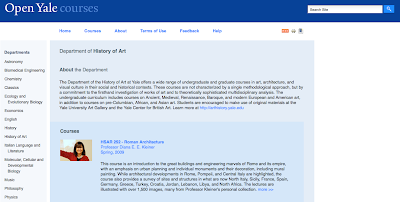- Does the course appear to be carefully pre-planned and designed for a distance learning environment? How so?
Yale University presents a model of Distance Education Open Source well organized for the student. After navigating for a while and visit various courses I felt comfortable with the easy navigation tools. The goal of the university is to share information presented in face-to-face courses. These are offered free with the purpose of sharing information and improve international relationships. The courses are designed in a simple way and where students can interact friendly. Each course presents the material in different forms such as readings, audio and videos accessing in a page of the course. All videos are available through ITunes and YouTube, offering the opportunity of accessing it from their IPods, tablets and smartphones. “The focus of the instruction shifts to visual presentations, engage learners and careful timing of presentations of information’s” (Simonson, et al, 2009).
Despite the presentation of the course is excellent it is obvious that the course has been design in a way that interaction between the learner and the instructor is not possible. Other limitation could be that there is no evidence that the learner completed the course. The course that I decided to explore was Roman Architecture of the Department of History of Art. To enrich this course the instructor Kleiner presents a study group using an external that provides space for a discussion board. This addition provides that interaction piece fundamental in an online course. I would say that the instructor took this initiative since the university platform does not provide space for this type of interaction
- Does the course follow the recommendations for online instruction as listed in your course textbook?
Yale University establishes clear communication in their about section that answer frequent asked questions. This section also provides information about how each course has being designed. Just wondering, does this course follow the recommendations for online instruction? The interaction between instructor and student is not fomented. Other elements of distance education courses are also missing. There is no assessment tool, discussion boards or a list of additional resources to learn more from the class. I need to give credit about the alternatives presented, which include text in html format, mp3 audio, video in flash and QuickTime format. These types of files become a valuable tool for those who interact with technology. “This is essential for purposes of student intellectual engagement” (Simonson, et al, 2009).
- Did the course designer implement course activities that maximize active learning for the students?
This course was designed in a standard format. To design a course it is important to consider the course outcomes. “Bloom’s taxonomy of educational objectives is extremely useful in this process” (Simonson, et al, 2009). This course in particular; Roman Architecture is designed with the purpose of sharing information with someone that has the need and interest of learning about the specific topic. There are no assessments included to measure growth and there is no interaction between instructor and learner. In my opinion this learning experience could be offered through ITunes as a podcast. I understand that Yale University wants to present this course in a more formal format. This offers the user a easy and fun learning experience.
Reference
Simonson, M., Smaldino, S., Albright, M., & Zvacek, S. (2009). Teaching and
learning at a distance: Foundations of distance education (4th ed.) Boston, MA: Pearson.
Reference
Simonson, M., Smaldino, S., Albright, M., & Zvacek, S. (2009). Teaching and
learning at a distance: Foundations of distance education (4th ed.) Boston, MA: Pearson.







No comments:
Post a Comment